M42 – The Orion Nebula

One of the most famous deep sky objects, the Orion nebula is a stellar nursery where young, hot massive stars are irradiating the gas cloud from which they were born, causing it to glow and develop ripples, bubbles and bow shocks as the radiation plows into the gas. Starbirth continues today as many protostars have also been discovered in the nebula.
The main nebula is designated M42 while the smaller spherical structure above it is M43. They are about 1340 light years away and being situated near the celestial equator they are visible from most inhabited places on earth.
At the heart of the nebula are four young stars known as the Trapezium, officially designated θ1 to θ4 Orionis. Their spectral types are O and B, these being the hottest, with typical surface temperatures in excess of 30,000K. This also implies they are very massive and will burn through their hydrogen fuel rapidly. They may be as young as 300,000 years and may only live for a few million before exploding as supernovæ. Thus the dinosaurs would never have seen M42, and neither will whatever is living on the earth in a hundred million years’ time!
This is the closest star-forming region to the solar system. It is about 24 light years across and is one of the brightest nebulæ, being visible to the naked eye in all but the most light-polluted skies. In fact its brightness poses a challenge for astrophotography and special processing techniques have to be used to produce an image that does justice to both the bright core and the fainter structures towards the edge.
Visible at the bottom of the frame is part of the bright halo of iota Orionis, a 2.75-magnitude star also called Na’ir al Saif.

An example of a bow shock and a bubble are shown in this extract from the main image. The bow shock is a little difficult to see, but may be discerned as a quarter-circle arc sweeping down and right from the circled star. The Hubble does a better job on this but it’s a lot bigger and doesn’t have to contend with the atmosphere!
The bubble is a little easier to see.
Equipment: Planewave CDK 14″ reflector on 10Micron GM2000 mount. FLI Proline P09000 CCD camera with Astrodon RGB filters.
Exposure times: Red, Green and Blue approx 4 hours each.
Data acquired with ACP Expert/Maxim DL and processed in PixInsight.


0 Comments